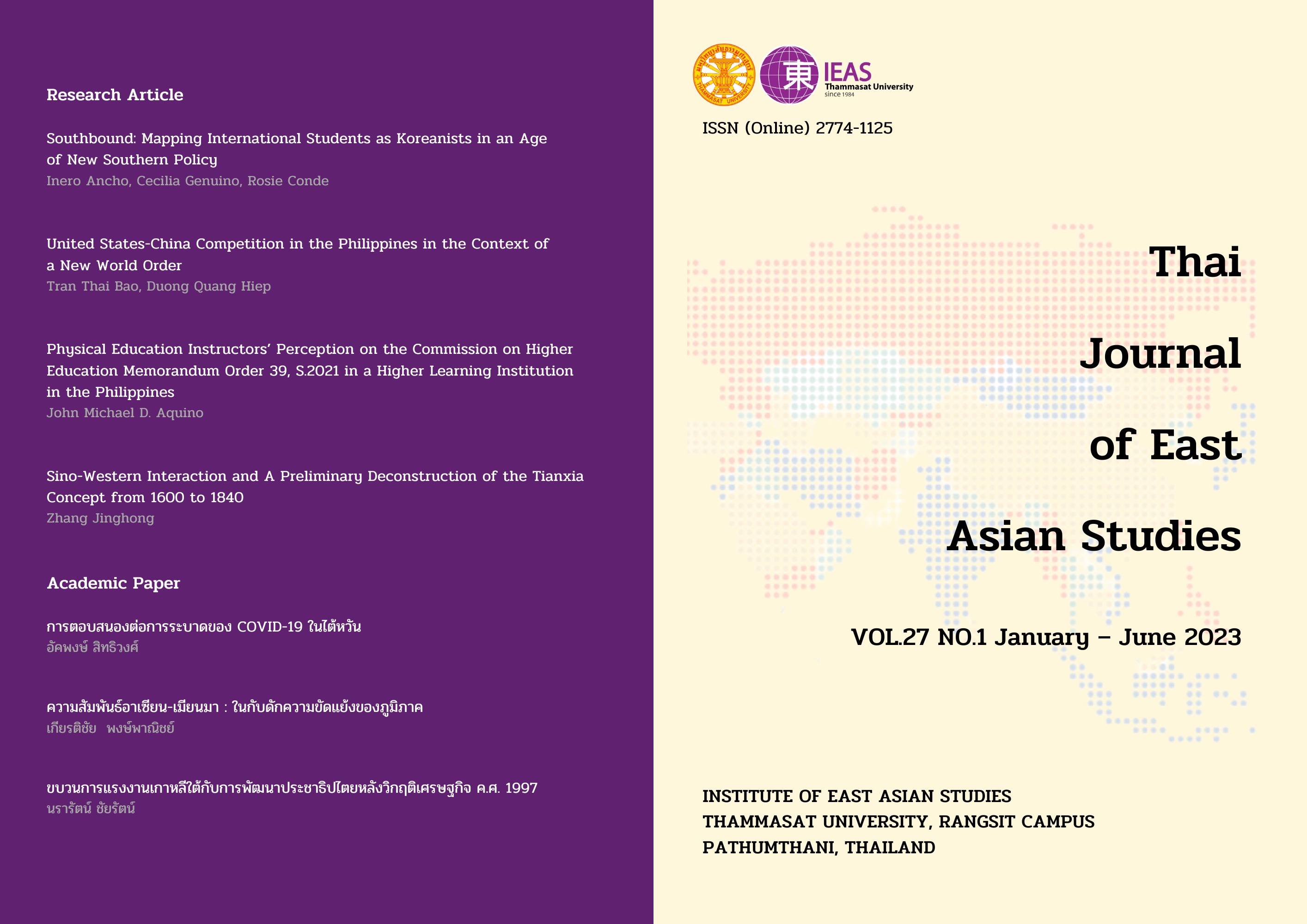Sino-Western Interaction and A Preliminary Deconstruction of the Tianxia Concept from 1600 to 1840
Keywords:
Tianxia, Sino-Western interaction, Preliminary deconstruction, Input-output analysisAbstract
Sino-Western interaction began around 1600, mainly in terms of Western learning spreading to the East. Western missionaries led by Matteo Ricci imported Western artifacts into China. At the time, China offered creative feedback under the influence of Western learning. Tianxia is a historical Chinese cultural concept that denoted either the entire geographical world or the metaphysical realm of mortals, and later became associated with political sovereignty. A preliminary deconstruction of the Tianxia concept is evident in the feedback process. This paper uses David Easton's input-output analysis to explain preliminary deconstruction of Tianxia conceptualizing in four sections: 1) Tianxia internal logic as political system; 2) preliminary deconstruction of the Tianxia concept at the height of Sino-Western interaction; 3) preliminary deconstruction of Tianxia during a lull in Sino-Western exchange; and 4) The Tianxia concept in other East Asian cultural and political entities. Results were that preliminary deconstruction of Tianxia did not amount to complete disintegration, but included supplementing the original concept and changing its qualities by evolving into a new concept through quantitative change.
Downloads
References
Bao-wei, Z. (2004). Towards Civilization: A Study on Hume’s Enlightenment Thought [Ph.D. in History, East China Normal University]. East China Normal University Library.
Edmund, E. B. & John, O. P. B. (1914). Annals and Memoirs of the Court of Peking (from the 16th to the 20th Century). Heinemann.
Elman, B. A. (1990). From Philosophy to Philology: Intellectual and Social Aspects of Change in Late Imperial China. Harvard University Asia Center. https://doi.org/10.2307/j.ctt1tg5kdt.7
Fairbank, J. K. (2009). The United States and China. Harvard University Press.
Gong-qin, X. (2022). The Dilemma of Confucian Culture: The Collision between Modern Scholar-bureaucrats and Chinese and Western Cultures. Shanxi People’s Press.
Henrietta, H. (2017). The Qianlong Emperor’s Letter to George III and the Early-Twentieth-Century Origins of Ideas about Traditional China’s Foreign Relations. The American Historical Review, 122(3), 680-701.
Hong, S. (2010). Creating Peace Forever. Beijing, China: China Development Press.
Hong, S.K. (2010). Reorganization of East Asian International Order before 1644 and Japan. Journal of Ming-Qing Historical Studies, 33, 81-110. https://doi.org/10.31329/JMHS.2010.04.33.81
Hui-peng, S. (2013). Man, Civilizational Entity, and International Relations. International Politics Quarterly, 34(4), 3-19.
Ji-lin, X. (2015). New Tianxiaism and China's Internal and External Order. In Ji-lin, Xu. & Qing, Liu (Eds.), New Tianxiaism (p. 7). Shanghai People’s Publishing House.
Ji-oh, S. (2019). Resolving the Misunderstood Historical Order: A Korean Perspective on the Historical Tributary Order in East Asia. Journal of the History of International Law, 21, 341–377.
Ming-ke, W. (2006). The Margin of China: Historical Memory and Ethnic Identity. Social Sciences Academic Press(China).
Qing, L. (2015). Seeking the Universality of Co-construction: From Tianxia Ideal to New Cosmopolitanism. Ji-lin, Xu. & Qing, Liu (Eds.), New Tianxiaism (pp. 54-63). Shanghai People’s Publishing House.
Ricci, M. (2018). Matteo Ricci Letters (Le Lettere dalla Cina) (Z., Wen, Trans.). The Commercial Press. (original work published 1913)
Ron-guey, C. (1994). A Reappraisal of Wang Fu-chih’s Thought of Nationalism. Bulletin of the Institute of Chinese Literature and Philosophy Academia Sinica, 4, 521-548.
Shao-xin, D. (2002). The Diffusion of Western Medicine at Guangzhou Port in the Early 19th Century. Journal of Maritime History, 2, 21-29.
Shigeki, I. (2022). Tribute, Maritime Ban, and Mutual Markets: The Truth of Transnational Trade in Modern East Asia in the Five Hundred Years (I. C., Liao, Trans.). Gusa Publishing. (original work published 2020)
Shu-lin, T. (2020). A Study of the Involvement in East Asian Diplomacy by British and American Missionaries in China: Centered on the Period Prior to the Mid-19th Century. South China Quarterly, 10(1), 48-61.
Su-min, X. (2012). The Influence of the Western Learning Spreading to the East in the Late Ming Dynasty on Wang Fuzhi’s Political Philosophy. Chuanshan Journal, 4, 1-10.
Su-min, X. (2012). The Western Learning Spreading to the East in the Late Ming Dynasty and the Breakthrough in Political Philosophy of “Ming Yi Dai Fang Lu”. Jianghan Tribune, 12, 34-41.
Tingyang, Z. (2021). All under Heaven: The Tianxia System for a Possible World Order. (J.E., Harroff, Trans.) University of California Press. (original work published 2010) https://doi.org/10.2307/j.ctv1n9dkth
Wai-ming, N. (2014). Names for China in Tokugawa Political Discourse. Journal of Asian History, 48(1), 61-79.
Wen-qin, S. (2015). J. S. Mill on China: “Stagnation” in the Context of 19th Century Political Thoughts. Journal of Social Sciences, 5, 150-158. https://doi.org/10.13644/j.cnki.cn31-1112.2015.05.017
Xing-wu, D. (2006). A Reinterpretation of “Tianxia Xingwang Pifu Youze” and Formation of Chinese Nation–State Consciousness in Modern Times. World Economics and Politics, 10, 14-20.
Zhao-guang, G. (2017). Here in “China” I Dwell: Reconstructing Historical Discourses of China for Our Time. Zhonghua Book Company.
Downloads
Published
How to Cite
Issue
Section
License
Copyright (c) 2023 Thai Journal of East Asian Studies

This work is licensed under a Creative Commons Attribution-NonCommercial-NoDerivatives 4.0 International License.



